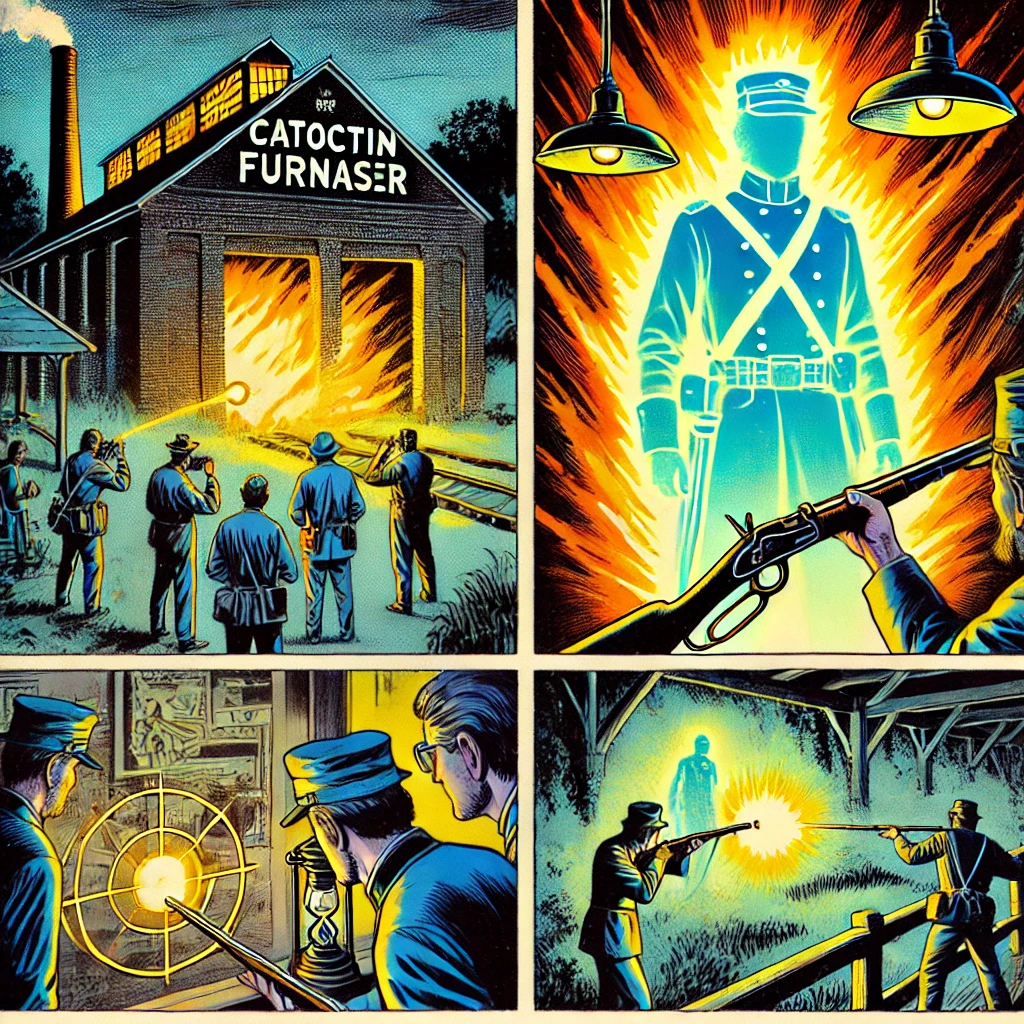Catoctin Furnace near Thurmont Maryland by Beverly Litsinger
In October 2002, Beverly Litsinger and her team conducted a paranormal investigation at Catoctin Furnace near Thurmont, Maryland. During their visit, they recorded a temperature of 114°F and an EMF (Electromagnetic Field) reading of 10 milligauss. According to local lore, near the end of the Civil War, a Union soldier assigned to guard the furnace was killed by a passing Confederate unit, who then disposed of his body in the furnace fire. Since then, witnesses have reported sightings of the soldier’s apparition, described as a Union soldier in uniform carrying a rifle, patrolling the furnace grounds. Some accounts claim that the apparition has attempted to shoot at tourists before vanishing.
We went to check out the Catoctin furnace. We got a reading of 114 degrees and 10 on our EMF meter.
Just before the Civil war ended, a soldier was assigned the duty of defending this small furnace that was being used to manufacture the Union weaponry. He was there for about a week when he was shot and killed by a passing Confederate unit. They tossed his body into the furnace fire.
People began to seen his ghost roaming the grounds guarding the furnace. People have described the Union soldier dressed in uniform with a rifle in his hand. He vanish right in front of people’s eyes. People say that the soldier is still guarding the furnace. It has been reported that he has tried to shoot the tourists.
SOURCE: v1 MGSA Oct 2002

Echoes in the Iron: The Haunted History of Catoctin Furnace
Just south of Thurmont, Maryland, in the shadow of Catoctin Mountain, lies the preserved site of Catoctin Furnace—a remnant of America’s early industrial ambitions and a location long rumored to harbor spiritual unrest. Originally constructed in the late 18th century, Catoctin Furnace operated for over a century as an ironworks complex, employing both free labor and enslaved people. While historians have documented the site’s industrial output, archaeological remains, and social history, local tradition also speaks of something less tangible: a lingering presence that continues to stir within the ruins, the hillside, and the workers’ cemetery nearby.
Founded in 1774 by the Johnson brothers, Catoctin Furnace produced iron for tools, weapons, and domestic goods. Its furnaces roared day and night, fueled by charcoal, limestone, and labor that included men, women, and children. The surrounding village grew with company housing, roads, and burial plots. Disease, exhaustion, and industrial accidents were common. Today, the reconstructed ironworker houses and preserved furnace stack stand in stark testimony to this difficult and often brutal way of life.
It is within this context that paranormal reports have emerged. One of the most persistent stories concerns the ironworkers’ cemetery, located just uphill from the main village. Visitors have reported hearing the sounds of shoveling or hammering in the distance, despite the site being unoccupied. Several individuals, including local hikers and amateur investigators, have described a sensation of being followed through the narrow trail leading to the cemetery, with no visible source. Audio anomalies recorded in the area include rhythmic thudding sounds and indistinct whispering, often dismissed as wind—yet sometimes captured under windless conditions.
The furnace stack itself is also a focal point of unexplained reports. On more than one occasion, witnesses have claimed to see brief glimmers of red-orange light emanating from the interior of the structure after nightfall—despite no fire having burned there in over a century. These lights are typically faint and vanish within seconds. Some interpret them as residual energy from years of intense heat and labor. Others associate them with apparitional activity—ghostly remnants of workers toiling even in death.
There are also less tangible but widely reported experiences: oppressive atmospheric pressure, sudden nausea, and a strong urge to leave the area without apparent cause. These sensations often center on the western edge of the village, near the locations where enslaved laborers are believed to have lived and worked under particularly harsh conditions. Interpretations vary, but the emotional weight of the site is commonly described by both believers and skeptics alike.
While no formal paranormal investigations are conducted on behalf of the state or preservation agencies, the site remains open to the public during daylight hours. Catoctin Furnace today is managed in part by preservation groups and archaeologists working to uncover and contextualize its layered history. Their work has revealed not only industrial remains but human remains as well—some of which are now part of ongoing studies into African American ancestry and labor in early American industry. These findings lend credence to the notion that the past here is not fully laid to rest.
The question that hangs over Catoctin Furnace is not simply whether it is haunted, but by whom—and why. The intersection of exploitation, fire, isolation, and death has created a place where history feels unusually close. For those who walk the ruins in silence, especially after the sun begins to fall behind the mountain, the presence of the past can feel uncomfortably near.
Bibliography
- McPherson, James M. Iron and Labor in Early America: The Case of Catoctin Furnace. Chesapeake University Press, 1981.
- Catoctin Furnace Historical Society. Village History, Archaeology, and Legacy, published reports 2005–2023.
- Thurmont Historical Society. Industrial Life and Death in Northern Frederick County. Internal Archive Report, 2009.
- Barnes, Christina. Ghosts of the Furnace: Folklore and Paranormal Lore of Catoctin. Self-published, 2017.
- Smithsonian Institution. Osteological and Isotopic Analysis of Catoctin Furnace Burials, Human Remains Project Report, 2020.